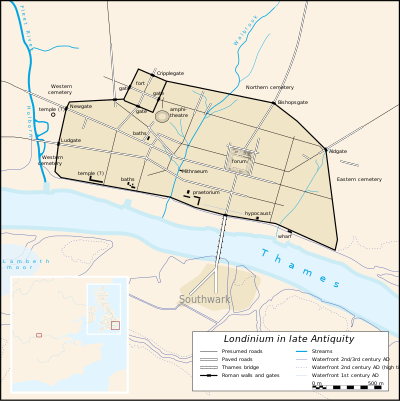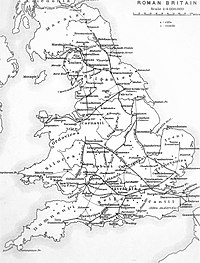Londinium: Difference between revisions
| (One intermediate revision by the same user not shown) | |||
| Line 51: | Line 51: | ||
*{{cite book|last=Wallace|first= Lacey M.|title=The Origin of Roman London|year= 2014|series= Cambridge Classical Studies|publisher= Cambridge University Press|location =Cambridge, UK |isbn=9781107047570}} | *{{cite book|last=Wallace|first= Lacey M.|title=The Origin of Roman London|year= 2014|series= Cambridge Classical Studies|publisher= Cambridge University Press|location =Cambridge, UK |isbn=9781107047570}} | ||
{{Major towns of Roman Britain}} | |||
{{Roman town}} | |||
[[Category:London]] | [[Category:London]] | ||
Latest revision as of 20:15, 5 March 2023

Londinium, Roman London, was the capital of Britannia during most of the period of Roman rule. It was originally a settlement established on the current site of the City of London, and was refounded by the Romans in around AD 47–50.[1][2] The new town sat at a key crossing point over the River Thames which turned the city into a road nexus and major port, serving as a major commercial centre in Roman Britain until its abandonment during the 5th century.
Following the foundation of the town in the mid-1st century, early Londinium occupied the relatively small area roughly half the area of the modern square mile of the City of London and equivalent to the size of present-day Hyde Park. In the year 60 or 61, the rebellion of the Iceni under Boudica compelled the Roman forces to abandon the town, which the Iceni razed. Following the defeat of Boudica by the governor Gaius Suetonius Paulinus a military installation was established[3] and the city was rebuilt. It had probably largely recovered within about a decade. During the later decades of the 1st century, Londinium expanded rapidly, becoming Britain's largest city, and it was provided with large public buildings such as a forum[4] and amphitheatre.[5]
By the opening of the 2nd century AD, Londinium had grown to perhaps 30,000 or 60,000 people, almost certainly replacing Camulodunum (Colchester) as the provincial capital, and by the mid-2nd century Londinium was at its height. Its forum-basilica was one of the largest structures north of the Alps when the Emperor Hadrian visited Londinium in 122. Excavations have discovered evidence of a major fire that destroyed much of the city shortly thereafter, but the city was again rebuilt. By the second half of the 2nd century, Londinium appears to have shrunk in both size and population.
Although Londinium remained important for the rest of the Roman period, no further expansion resulted. The town supported a smaller but stable settlement population as archaeologists have found that much of the city after this date was covered in dark earth—the by-product of urban household waste, manure, ceramic tile, and non-farm debris of settlement occupation, which accumulated relatively undisturbed for centuries. At some time between 190 and 225, the Romans built a defensive wall around the landward side of the city. The London Wall survived for another 1,600 years and broadly defined the perimeter of the old City of London.
Name
The etymology of the name Londinium is unknown. Following Geoffrey of Monmouth's pseudohistorical History of the Kings of Britain, it was long published as derived from an eponymous founder named Lud, son of Heli. There is no evidence such a figure ever existed. Instead, the Latin name was probably based on a native Brittonic place name reconstructed as *Londinion. Morphologically, this points to a structure of two suffixes: -in-jo-. However, the Roman Londinium was not the immediate source of English "London" (Lunden in Old English, which appears derived from a native British language name): this suggests an alternative Brittonic form Londonion.[6] Alternatively, the local pronunciation in British Latin may have changed the pronunciation of Londinium to Lundeiniu or Lundein.[7] The list of the 28 cities of Britain included in the 9th-century History of the Britons precisely notes London in Old Welsh as Cair Lundem.
Location

The site guarded the Romans' bridgehead on the north bank of the Thames and a major road nexus shortly after the invasion. It was centred on Cornhill and the River Walbrook, but extended west to Ludgate Hill and east to Tower Hill. Just prior to the Roman conquest, the area had been contested by the Catuvellauni based to the west and the Trinovantes based to the east; it bordered the realm of the Cantiaci on the south bank of the Thames.
The Roman city ultimately covered at least the area of the City of London, whose boundaries are largely defined by its former wall. Londinium's waterfront on the Thames ran from around Ludgate Hill in the west to the present site of the Tower in the east, around a mile. The northern wall reached Bishopsgate and Cripplegate near the Museum of London, a course now marked by the street "London Wall". Cemeteries and suburbs existed outside the city proper. A round temple has been located west of the city, although its dedication remains unclear.
Substantial suburbs existed at St Martin-in-the-Fields in Westminster and around the southern end of the Thames bridge in Southwark in Surrey, where excavations in 1988[8] and 2021 have revealed an elaborate building with fine mosaics and frescoed walls dating from 72 AD.[9][10] Inscriptions suggest a temple of Isis was located there.[11]
Status
Londinium grew up as a vicus, and soon became an important port for trade between Britain and the Roman provinces on the continent. Tacitus wrote that, at the time of the uprising of Boudica, "Londinium... though undistinguished by the name of 'colony]]', was much frequented by a number of merchants and trading vessels.
Depending on the time of its creation, the modesty of Londonium's first forum may have reflected its early elevation to city (municipium) status or may have reflected an administrative concession to a low-ranking but major Romano-British settlement.[12] It had almost certainly been granted colony (colonia) status prior to the complete replanning of the city's street plan attending the erection of the great second forum around the year 120.[13]
By this time, Britain's provincial administration had also almost certainly been moved to Londinium from Camulodunum (now Colchester in Essex). The precise date of this change is unknown, and no surviving source explicitly states that Londinium was "the capital of Britain" but there are several strong indications of this status: 2nd-century roofing tiles have been found marked by the "Procurator" or "Publican of the Province of Britain at Londinium", the remains of a governor's palace and tombstones belonging to the governor's staff have been discovered, and the city was well defended and armed, with a new military camp erected at the beginning of the 2nd century in a fort on the north-western edge of the city, despite being far from any frontier.[14] Despite some corruption to the text, the list of bishops for the 314 Council of Arles indicates that either Restitutus or Adelphius came from Londinium. The city seems to have been the seat of the diocesan vicar and one of the provincial governors following the Diocletian Reforms around the year 300; it had been renamed Augusta – a common epithet of provincial capitals – by 368.[15]
Outside links
| ("Wikimedia Commons" has material about Londinium) |
- Roman London, History of World Cities
- A map of known and conjectural Roman roads around Londinium, from London: A History
- The eastern cemetery of Roman London: excavations 1983–90, Museum of London Archive
References
- ↑ Hingley, Richard (9 August 2018). Londinium : a biography : Roman London from its origins to the fifth century. London. pp. 27–32. ISBN 978-1-350-04730-3. OCLC 1042078915.
- ↑ Hill, Julian. and Rowsome, Peter (2011). Roman London and the Walbrook stream crossing : excavations at 1 Poultry and vicinity, City of London. Rowsome, Peter., Museum of London Archaeology.. London: Museum of London Archaeology. pp. 251–62. ISBN 978-1-907586-04-0. OCLC 778916833.
- ↑ Dunwoodie, Lesley. (2015). An early Roman fort and urban development on Londinium's eastern hill : excavations at Plantation Place, City of London, 1997-2003. Harward, Chiz., Pitt, Ken.. London: MOLA (Museum of London Archaeology). ISBN 978-1-907586-32-3. OCLC 920542650.
- ↑ Marsden, Peter Richard Valentine. (1987). The Roman Forum Site in London : discoveries before 1985. Museum of London.. London: H.M.S.O. ISBN 0-11-290442-4. OCLC 16415134.
- ↑ Bateman, Nick. (2008). London's Roman amphitheatre : Guildhall Yard, City of London. Cowan, Carrie., Wroe-Brown, Robin., Museum of London. Archaeology Service.. [London]: Museum of London Archaeology Service. ISBN 978-1-901992-71-7. OCLC 276334521.
- ↑ Jackson, Kenneth H. (1938). "Nennius and the 28 cities of Britain". Antiquity 12 (45): 44–55. doi:10.1017/S0003598X00013405.
- ↑ Peter Schrijver, Language Contact and the Origins of the Germanic Languages (2013), p. 57.
- ↑ The London Archaeologist 1988 Vol 5 No. 14
- ↑ The Liberty of Southwark https://thedig.thelibertyofsouthwark.com/
- ↑ London's largest Roman mosaic find for 50 years uncovered https://www.bbc.co.uk/news/uk-england-london-60466187
- ↑ White, Kevan (2016-02-07). "LONDINIVM AVGVSTA". http://roman-britain.co.uk/places/londinium.htm.
- ↑ Merrifield, pp. 64–66.
- ↑ Merrifield, p. 68.
- ↑ Wacher, p. 85.
- ↑ "Living in Roman London: From Londinium to London". London: The Museum of London. http://archive.museumoflondon.org.uk/Londinium/analysis/publiclife/administration/4+Londin.htm.
- Billings, Malcolm (1994), London: a companion to its history and archaeology, ISBN 1-85626-153-0
- Brigham, Trevor. 1998. “The Port of Roman London.” In Roman London Recent Archeological Work, edited by B. Watson, 23–34. Michigan: Cushing–Malloy Inc. Paper read at a seminar held at The Museum of London, 16 November.
- Hall, Jenny, and Ralph Merrifield. Roman London. London: HMSO Publications, 1986.
- Haverfield, F. "Roman London." The Journal of Roman Studies 1 (1911): 141–72.
- Hingley, Richard, Londinium: A Biography: Roman London from its Origins to the Fifth Century, 2018, Bloomsbury Publishing, ISBN 1350047317, 9781350047310
- Inwood, Stephen. A History of London (1998) ISBN 0-333-67153-8
- John Wacher: The Towns of Roman Britain, London/New York 1997, p. 88–111. ISBN 0-415-17041-9
- Gordon Home: Roman London: A.D. 43–457 Illustrated with black and white plates of artefacts. diagrams and plans. Published by Eyre and Spottiswoode (London) in 1948 with no ISBN.
- Milne, Gustav. The Port of Roman London. London: B.T. Batsford, 1985.
- Sheppard, Francis, London: A History, 2000, Oxford University Press, ISBN 0192853694, 9780192853691, google books
Further reading
- Perring, Dominic (2022). London in the Roman World. Oxford, UK: Oxford University Press. ISBN 978-0-19-878900-0.
- Wallace, Lacey M. (2014). The Origin of Roman London. Cambridge Classical Studies. Cambridge, UK: Cambridge University Press. ISBN 9781107047570.
| Major towns of Roman Britain |
|---|
|
Capitals: Londinium (London) • Eboracum (York) • Camulodunum (Colchester) |
|
Caesaromagus (Chelmsford) • Calleva Atrebatum (Silchester) • Corinium Dobunnorum (Cirencester) • Deva Victrix (Chester) • Durovernum Cantiacorum (Canterbury) • Durnovaria (Dorchester) • Glevum (Gloucester) • Isca Augusta (Caerleon) • Isca Dumnoniorum (Exeter) • Isurium Brigantum (Aldborough) • Lactodurum (Towcester) • Lindum Colonia (Lincoln) • Luguualium (Carlisle) • Moridunum (Carmarthen) • Noviomagus Reginorum (Chichester) • Petuaria (Brough) • Ratae Corieltauvorum (Leicester) • Venta Belgarum (Winchester) • Venta Silurum (Caerwent) • Verulamium (St Albans) • Viroconium Cornoviorum (Wroxeter) |
|
Lost: Alchester (Wendlebury) • Bannaventa (Northamptonshire) • Cunetio (Wiltshire) • Venta Icenorum (Norfolk) |
